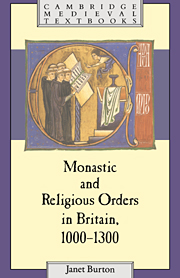Book contents
- Frontmatter
- Contents
- List of illustrations
- Preface
- 1 Before the Normans
- 2 The coming of the Normans
- 3 The regular canons
- 4 The new monastic orders of the twelfth century
- 5 Women and the religious life
- 6 The mendicant orders
- 7 The physical setting: monastic buildings and the monastic plan
- 8 Inside a religious house: daily life and the chain of command
- 9 Learning and literary activities
- 10 Religious houses and the wider community: founders, patrons and benefactors
- 11 The monastic economy
- 12 On the brink of change
- Glossary
- Notes
- Select bibliography
- Index
- Cambridge Medieval Textbooks
Preface
Published online by Cambridge University Press: 05 June 2012
- Frontmatter
- Contents
- List of illustrations
- Preface
- 1 Before the Normans
- 2 The coming of the Normans
- 3 The regular canons
- 4 The new monastic orders of the twelfth century
- 5 Women and the religious life
- 6 The mendicant orders
- 7 The physical setting: monastic buildings and the monastic plan
- 8 Inside a religious house: daily life and the chain of command
- 9 Learning and literary activities
- 10 Religious houses and the wider community: founders, patrons and benefactors
- 11 The monastic economy
- 12 On the brink of change
- Glossary
- Notes
- Select bibliography
- Index
- Cambridge Medieval Textbooks
Summary
From the beginnings of the Christian era, men and women have always sought the perfect way to serve their God in obedience to the commandments laid down by Christ himself Their efforts have led to many forms of religious life and service, both within the world as layfolk or as churchmen, and withdrawn from it, as members of religious communities devoted in different ways to the service of God. The word ‘monk’ itself derives from the Greek monos, meaning one, alone, and has always described those who sought the solitary life, as hermits in the desert, in the European countryside, or enclosed in cells adjoining the walls of parish churches and elsewhere. But the term ‘monasticism’ as we most frequently use it refers – somewhat paradoxically – to religious life within communities. As such, monasticism has been, and continues to be, a central part of the Christian experience, a unique experiment in community life.
This book explores the ways in which men and women's ideals of how best they might achieve this goal of perfect communal life altered and developed over a period of roughly three hundred years. The scope, geographically, is England, Wales and Scotland. However, the approach taken in the first two chapters of this work is chronological, in that they survey the state of monastic life in the sixty years before the Norman Conquest of England, and analyse how religious institutions developed in the forty years or so thereafter.
- Type
- Chapter
- Information
- Monastic and Religious Orders in Britain, 1000–1300 , pp. ix - xiiPublisher: Cambridge University PressPrint publication year: 1994

